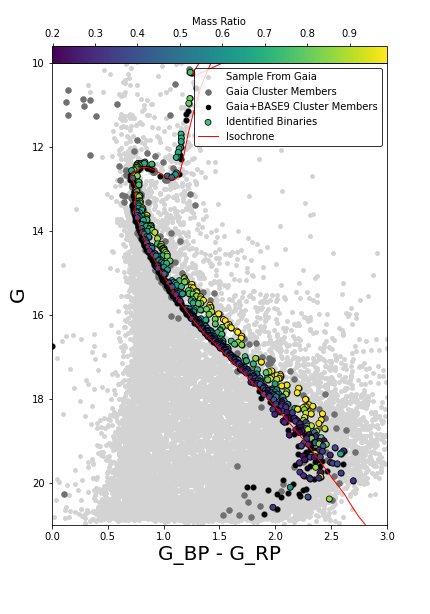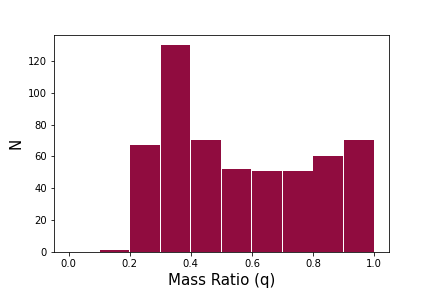About Me
My name is Erin Motherway and I am currently a rising senior as Embry-Riddle Aeronautical University in Daytona Beach. I am majoring in Astronomy & Astrophysics with a minor is computational mathematics. Along with Claire Zwicker and Rafael Catana, I have been working with Aaron Geller this Summer to use the tool BASE-9 to identify binary stars in open clusters and determine their mass-ratios. Apart from doing research, I am a musician and I love to read.

Introduction
Open clusters are ideal for studying stellar evolution and dynamics as the stellar populations of these clusters were formed at the same time, giving them similar stellar parameters such as age, metallicity, distance, and reddening. Binary systems can offer significant insight into the environmental dynamics and evolution of open clusters as a result of their unique behavior and dynamics. The binary population in open clusters are continually changing as a result of mergers, close interactions, and energy exchanges (Geller et al. 2021).
M35(NGC 2168) and M67(NGC 2682) are the main focuses of this study and have been well researched in terms of radial velocity, photometry, binary orbits, proper motion, etc. M35 is a young open cluster with an age of 150 ± 25 Myr, a distance of 805 ± 40 pc, a metallicity of [Fe/H] = −0.18 ± 0.05, and a reddening of E(B − V) = 0.20 ± 0.01. M67 is an older open cluster with an age of 4 Gyr, a distance of 850 pc, a metallicity of [Fe/H] between 0.05 and 0.10, and a reddening of E(B – V) between 0.015 and 0.056 (Geller et al. 2021) . Both clusters are home to a heavy population of binary systems and unique dynamics. As a result of their age difference, comparing the binary characteristics of these two clusters could offer significant insight into the evolution of the binary population in open clusters. We hope to report trends within individual clusters and across many clusters, with specific emphasis on how binary characteristics evolve over time as a result of the local stellar environment.Methods
In order to determine the properties of M35 and M67 along with identifying their binary population, we used a Bayesian statistics tool, Bayesian Analysis of Stellar Evolution(BASE-9). BASE-9 has two main functions that were utilized. The first, singlePopMcmc, employs Markov Chain Monte Carlo method of sampling along with Bayesian techniques to derive precise values for properties of a single population star cluster. This software takes in photometry data for the cluster along with certain priors and produces values for the log age, distance, metallicity, and reddening of the cluster. The photometry data is pulled from Gaia and manipulated to get the best results from singlePopMcmc. We download stars from Gaia within a 1-degree radius of M67’s central right ascension and declination. In order to remove field stars from the sample. We then fit distributions to the radial velocity [km/s], distance [pc], and proper motion [mas/yr], which allowed us to calculate a combined cluster membership probability for each star. We remove all stars with a membership probability less than 0.01, as these are not likely members of the cluster. In order to get the best sampling from singlePopMcmc, we only included Pan-STARRS and Gaia photometry filters and excluded stars with a G magnitude fainter than 14. For M67, a total of 1032 stars were used. The second function that we will be using, sampleMass, uses the results from running singlePopMcmc along with the photometry data to identify binary stars, derive their primary masses and mass ratios, and establish cluster memberships.




Using the Cluster’s right ascension and declination, we pulled a 1-degree radius of stars from Gaia. We then found the peak radial velocity [km/s], distance [pc], and proper motion [mas/yr] of all stars within the 1-degree radius. The combination of these peak values allows us to find a membership probability for each star. Each star with a calculated membership probability less than 0.01 is then considered a field star and is not included in the sample. In the Color Magnitude Diagram shown in this section, all stars from Gaia are shown in gray. The pink stars are those we found to be cluster members using the method described above. To get the best sampling from the singlePopMcmc function of BASE-9, we only included Pan-STARRS and Gaia photometry filters for stars in the main sequence turn off.
Results
After using the singlePopMcmc function on the open cluster M67, the following parameters were derived: Age(Gyr) = 3.656 ± 0.009, [F e/H] = −0.080 ± 0.0043, dist = 9.881 ± 0.0053, Av = 0.2118 ± 0.0030. Note the small errors corresponding to each value. These demonstrate the extreme precision of BASE-9. However, these errors should also be considered with BASE-9’s inability to recognize errors in the models that it uses to derive these parameters. It is also clear in figure 1 that BASE-9 did not fit the cluster well towards the Red Giant Branch, so it is possible the binaries identified in this region might be single stars.

From the 1032 star sample of M67, 552 binary stars were identified, along with their mass ratios. These values give a binary frequency of 0.535 ± 0.023. However, as stars get closer to the main sequence, the mass ratio becomes smaller, making it harder to detect binaries. This trend in mass ratios is visualized in figure 1. As a result, we can set a threshold at q = 0.5, leaving q < 0.5 incomplete. For q > 0.5, the binary frequency becomes f = 0.298 ± 0.017, which is comparable to the frequency found by Albrow & Ulusele (2022).

After solidifying our procedure for our current trial clusters, we plan to repeat this process with hundreds of clusters to look into how the birth characteristics of binary stars are impacted by their environment and how they evolve over time. Across these different clusters, we will also compare trends in binary fraction vs. cluster age, mass, distance from the Galactic Center, etc. The next step specifically is to apply this procedure to the young cluster M35 to compare binary frequency and mass distribution trends to those of the older cluster M67.
Acknowledgements
This material is based upon work supported by the National Science Foundation under grant No. AST-2149425, a Research Experiences for Undergraduates (REU) grant awarded to CIERA at Northwestern University. Any opinions, findings, and conclusions or recommendations expressed in this material are those of the author(s) and do not necessarily reflect the views of the National Science Foundation. This research was supported in part through the computational resources and staff contributions provided for the Quest high performance computing facility at Northwestern University which is jointly supported by the Office of the Provost, the Office for Research, and Northwestern University Information Technology. A special thanks to Claire Zwicker and Rafael Catena for their collaboration and also Ted von Hippel for continued guidance on the project. Another big thank you to Elizabeth Jefferey, Roger Cohen, Elliot Robinson, and the rest of the BASE-9 team